April 24 - 30, 2022: Issue 535
Captain Michael Maley CSC DSM RAN, President Of Avalon Beach RSL Sub-Branch
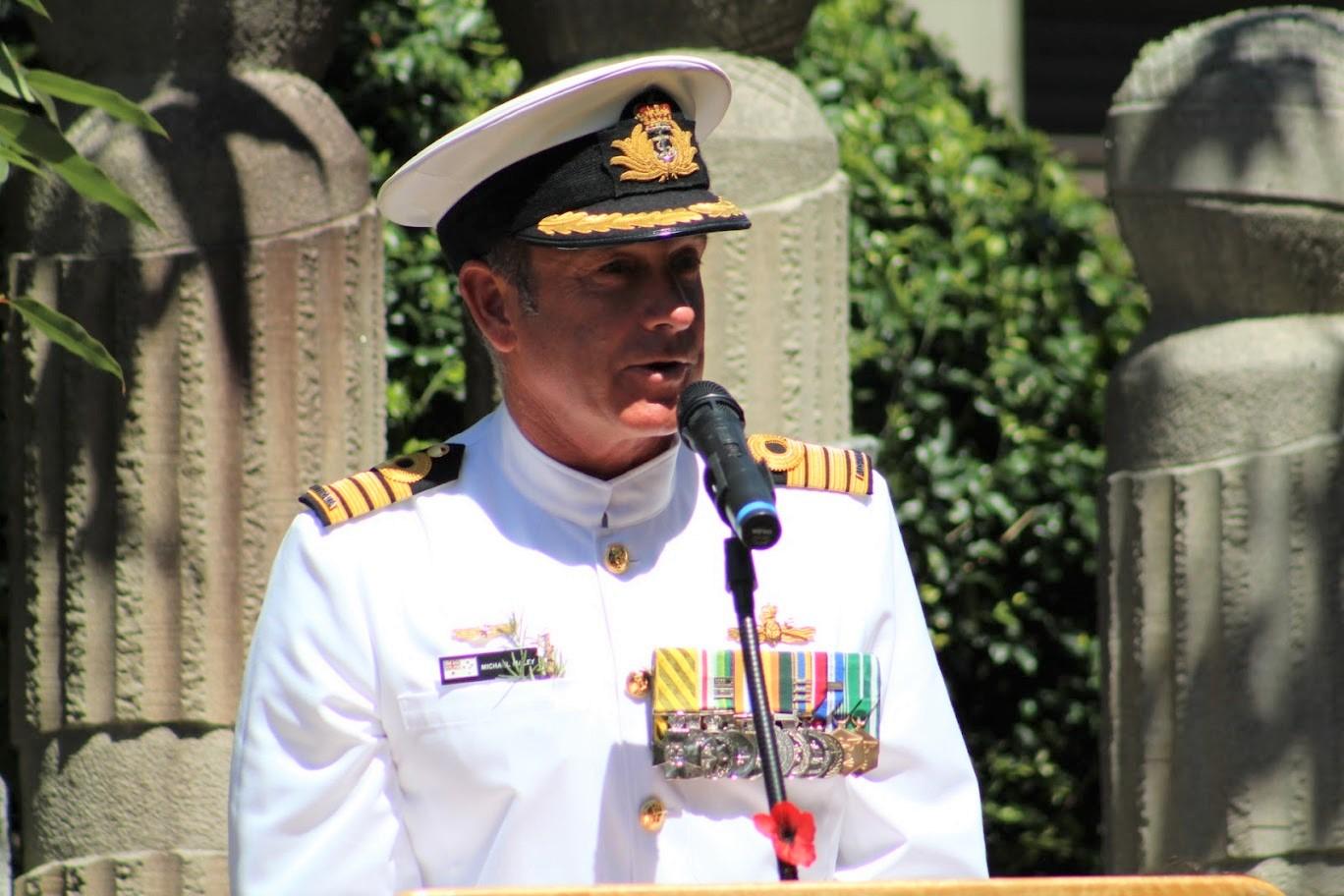
Captain Michael Maley CSC DSM, President Of Avalon Beach RSL Sub Branch, joined the Royal Australian Navy from Bega High School in 1983 and graduated from the Naval College in 1985.
After completing training in Navigation, Seamanship and Warfare he served in a variety of ships as Officer of the Watch, Navigator and Executive Officer.
In 1994, he undertook the Clearance Diving Officers’ qualifying course, which encompassed diving, explosive ordnance disposal and mine warfare.
Following that course he had two commands - HMAS Shoalwater and Australian Clearance Diving Team One.
When in command of Team One it was awarded a Fleet Award, the Rushcutter Shield for proficiency and efficiency.
In 2012 while a Commander, Capt. Maley gave the Anzac Day Address at Avalon Beach RSL Sub-Branch's Commemorative Service. It was the community's initial introduction to a gentleman who has been serving our community and Service personnel through this Sub-Branch for 10 years this coming Monday April 25th, Anzac Day 2022.
Capt. Maley was asked by Commodore Graham Sloper AM RAN to take up this position during Commodore Sloper's final time here with us. Captain Maley, like Graham had, includes everyone and seeks to bridge the gap between ignorance and understanding for those who have served and those who have not, which that 2012 Address clearly illustrates.
The record of the Anzac Day Address at Avalon RSL, given that year by Commander Michael Maley DSM (Distinguished Service Medal) RAN:
Before this day who had heard word the ANZAC. Hereafter; who would ever forget?
Commodore Sloper and Distinguished guests, Returned Service men and women, currently serving members, residents of the Northern Beaches and most importantly Children of Avalon Beaches, and the Peninsula - for it is you that will carry forward the baton of the ANZAC tradition and keep alive something so sacred and so entwined into the very fabric of Australian society- the mourning of the dead, the remembrance of a sacrifice and the celebration of a courage that gave birth to a nation.
In the half light of early dawn April 25 1915 thousands of Australian and New Zealand young men stormed ashore on a lonely cove in Suvla Bay. By days end history tells us that 50 Aussies were dead - many dying either on the waters edge-or less than 50 metres up the beach. In the words of Eric Bogle," we was butchered like lambs at the slaughter." The dead ranged from farmers and clerks to a fifth year medical student and even a member of parliament.
The nine months that followed will forever be remembered as a period that shaped a nation. Australians were fighting under their own banner, no longer that of the mother country. They were ANZACS and no matter what the odds they would never give up, no matter what the odds they would exhibit extreme courage, no matter what the odds they would exhibit profound mateship and no matter what the odds they would forge ahead as Aussies. Australia had come of age. But at a sacrifice, the sacrifice of people like Private Humphries, and Private Denahy of Avalon NSW.
Today, all over Australia communities come together from dawn to noon to celebrate the legend of the ANZAC and in doing so pay homage to the sacrifices that Australian Service Men and Woman have given through two world wars, Korea, Malaya, Vietnam, Timor, Kuwait, Iraq and Afghanistan. ANZAC Day was forged on 25 April 1915 but belongs to the 100,000 souls that died under the banner of the Union Jack and the Southern Cross so that we may be who we are today. From ANZAC cove, Australian soldiers were redeployed to the Western Front. At a time when the Australian population was but a few million, we lost 51 000 young men. To have stood in the war cemeteries of Ypres and Passchendaele is something that will live with me forever. In the words of one war historian, ‘there is no land sown more heavily with the seeds of Australian sacrifice.’ To stand at the gravestone of a soldier with two names, knowing that he has signed up under an alias because he was under 18 is indescribable. At that age he could have been playing for the Pittwater Tigers, taking his HSC at Barrenjoey or surfing for Newport Plus.
In World War Two Australians carried forth the legend of ANZAC, distinguishing themselves in combat in places as diverse as Tobruk, Kokoda and the Solomon Islands. The Warriewood bus shelter memorial contains the names of five men killed in WWII, the Mona Vale Primary School honour roll shows the names of more and the Avalon Beach RSL has names such as LEUT Samuel McCaughey killed in New Guinea.
In Korea and Vietnam Aussies continued the sacrifice, displayed outstanding courage and held their own in battles such as Kapyong and Long Tan. And yes names of Avalon men sadly are emblazoned on the honour role. Lt John Fraser and Capt. Analdy Danilenko, Killed in Action, Vietnam.
In Borneo, Malaya, Timor, Kuwait and Iraq, Australian men and women served with distinction, moral integrity and courage akin to that of the ANZACS.
Today thousands of miles from home in places such as Tarin Kowt, Uruzgan, Kandahar and Kabul, a very special group of men and women will pay respect to the ANZACs, stand to attention as the last post is played, say those sacred and enshrined words- Lest We Forget. They will then put on their body armour pick up their guns and get back to work knowing that we at home wish them a safe return. They are very much the modern day ANZACs who I can assure you are doing our country proud and achieving great things while you and I go about our daily business- The price of liberty is eternal vigilance.
Most surely today wives, families and friends of Australia’s 32 fallen will stand at the graves of their ANZACS and mourn their loss, applaud their courage and realize the enormity of their sacrifice, and we should do the same. Today when the last post is played and we feel that tingle up our spine, that is those 32 ANZACS saying do not forget us or those that have gone before us- do not forget the courage, the sacrifice and the legend of the ANZAC.
And you know what, as a returned servicemen I feel very comfortable knowing that the children of today will carry forth the ANZAC baton. Whether it be turning up to march proudly wearing the medals of their Grandparents, turning up to cheer on the Diggers or simply knowing through their education what is meant by the word ANZAC for in the words of a 12 year old poet it is "a story that must forever be told".
When deployed to Afghanistan, we received many gift packs and letters from schools, most notably in the Manning Shire. Let me read out two of them.
First from a Brooke Sullivan of Holiday Point; “Dear Army men and women. I hope you are proud of yourself because I would be too scared to do your job.”
And this one from nine year old Keith; ‘Yo Bra, I hope you are well. Thank you for serving our country. Peace out homie.”
Although as a Generation X I do not really think of myself as 'Bra', knowing that these young children had taken the time to send us thoughts of support boosted morale to a level that you just cannot imagine. So yes I feel very comfortable that the ANZAC spirit will be carried forth by the "bras" of the younger generation.
In finishing, there is a very evocative song about ANZAC Day by Eric Bogle called "And the Band Played Waltzing Matilda" in which he says “As year follows year, more old men disappear and soon no none will march there at all". But year has followed year and all the ANZACs have disappeared- but look at how many people come out to March, look how many have turned out today in Avalon, look at the hundreds of thousands that turn out in Sydney and Melbourne. Because Australia and Australians will never ever forget the sacrifice, the courage and the Legend -"To the end to the end they remain"
Lest we forget.
.jpg?timestamp=1650695525907)
This week we'd like to share a few insights into the current President of Avalon Beach RSL Sub-Branch from that gentleman himself, along with what will be coming up in this year's Avalon Beach RSL Sub-Branch Commemorative Services at Dawn and at 11am.
You’re a Bega High School boy?
Yes I am, I did all my secondary schooling at Bega but I moved around a fair bit before that. Dad was a Primary school Teacher so we’d moved around to a few other places prior to that but I still call that area my home as I did six years at Bega.
What were your favourite things to do there – were you going near the water?
Yes – mum and dad are at Tathra now so as a kid growing up down there it was surfing, snorkelling, spear fishing, as well as playing a lot of sports, rugby league I’d play during the Winter but generally water sports.
Did you have a favourite break to go surfing at?
Yes. There are two great spots there, one called Middle Beach, which is up between Tathra and Bermagui, and the other is a place called Bunga Headland which is a really remote area just south of Bermagui which breaks on a really big southerly swell.
So, you’re a charger then?
(laughs) I try – I still go to Fiji every year to Cloudbreak.
I see you earned a BA for History at the UNSW?
Yes – I was going through the Naval College and so did History through that. I probably should have majored in something else, but it wasn’t too bad. I did go on later in life to gain a Post-Graduate Masters in Business Administration which I found pretty fascinating.
The RAN media photobank has a LOT of photos of you shaking hands with people – graduates from the Mine Warfare and Clearance Diving capability for the Royal Australian Navy as well as in official functions – does your hand get tired?
Yes - sometimes (laughs). Along with those opportunities to congratulate graduates I’ve also done a lot of diplomatic jobs and been fortunate to meet some pretty outstanding people, so there is a fair amount of greetings of that kind.
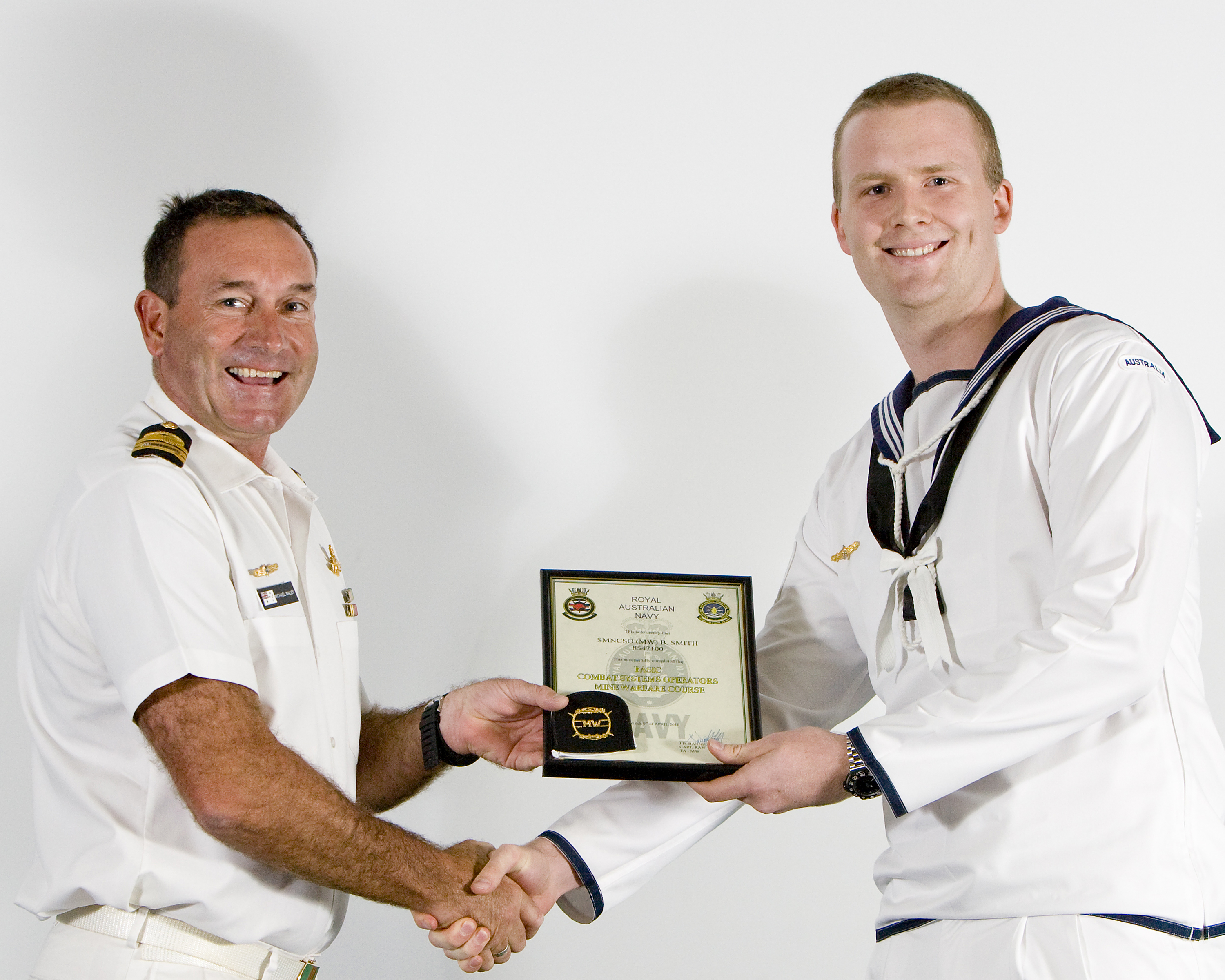
Commander Michael Maley, RAN, presents Seaman Combat Systems Operator (Mine Warfare) Blair Smith with his graduation certificate and rate badges. The Basic Combat Systems Operator Mine Warfare training commenced at HMAS Watson, with 8 weeks of core CSO and GCCS training. The course then moved to HMAS Waterhen where the students undertook 12 weeks of Mine Warfare training, including a 2 week period in the CSO Trainer as part of their final assessment. September 2010. Image courtesy Royal Australian Navy.
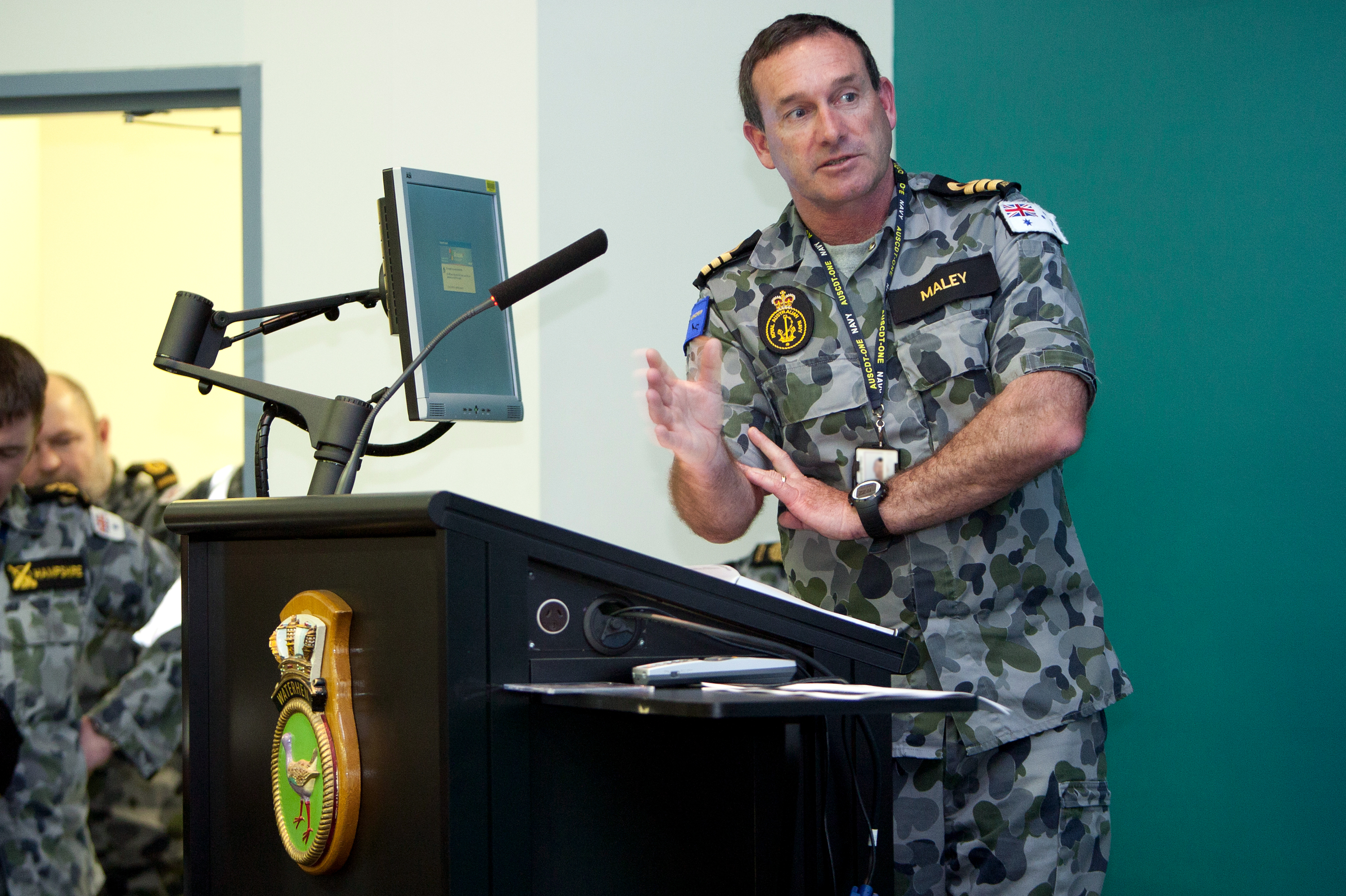
Commander Michael Maley, from the Mine Warfare and Clearance Diving Group makes a presentations as part of the Mine Clearance Diving Continuous Improvement Program at a clear lower deck for all HMAS WATERHEN personnel. October 2010. Image courtesy Royal Australian Navy.
After joining the Royal Australian Navy (RAN) you went into the field of the Mine Warfare and Clearance Diving capability for the Royal Australian Navy – why did you choose that area?
A number of reasons but first of all my affinity with the water. This is also a Branch within the Navy that’s very diverse. They place a lot of emphasis on a high level of physical fitness and really pushing your limits, and that’s what attracted me to it as well, and it definitely hasn’t let me down in that area. I was attracted primarily for the diving side of this Branch, Mine Warfare is an adjunct to this. As it turned out there has been a focus on that and what I was deployed to Iraq doing.
You went to the US in 2003 as well – what were you doing then?
I did an exchange program where I worked within the US Navy’s Mine Warfare Command. I was tasked with setting up an experimental Unit that was across the US Marine Corps, the US Special Forces and the US Navy. It was probably one of the most fascinating things I’ve done in my life.
The US people have kindly supplied us with a photo of you about to abseil off scaffolding while there – what were you doing during that exercise?
When we operate with the US there are a lot of methods of getting inserted into areas. Sometimes this is by helicopter, so you have to abseil or repel, where you’re attached to a rope. At other times you have to do what’s called ‘fast-roping’ where you basically hold on to the rope and use your hands to control your rate of descent down that from about 90 feet. You also sometimes have to use abseiling where you are going into an area where you may be cave-diving or some remote ordnance disposal.
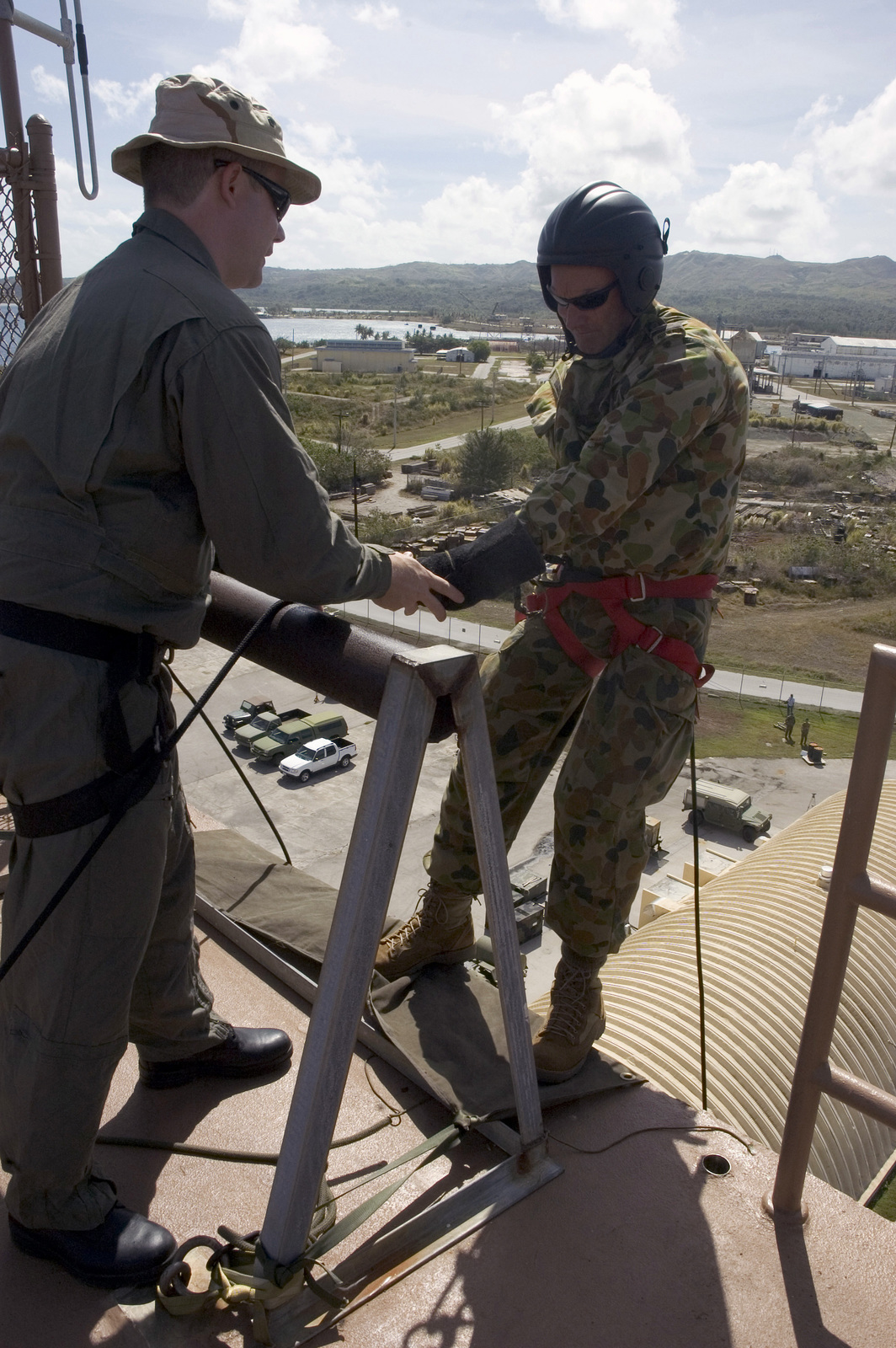
US Navy (USN) CHIEF PETTY Officer (CPO) Jeremy Logan (left), assigned to Explosive Ordnance Disposal Mobile Unit 5 (EODMU-5) gives last-minute advice to Royal Australian Navy (RAN) Lieutenant Commander (LCDR) Michael Maley, before he goes over the side of a wall during a fast rope exercise conducted at Santa Rita Naval Base, Guam (GU), during the Annual Multi-national Explosive Ordnance Disposal (EOD) Exercise known as TRICARB 2006." The Exercise brings together EOD Units from the US, Australia and Singapore. Image courtesy USN.
You have also represented the Australian Navy at NATO Forums – what does that involve?
I’ve done a number of NATO Forum representations. I had the honour in 2008-2009 of being Chairman of a NATO panel, which was very rare that they actually let Australia take the lead. As we had the subject matter expertise in that area, we actually as an invited member of that took Chairmanship. Then recently I was deployed to Afghanistan and was the Director of Strategic Plans for the NATO Special Operations Forces deployed to Afghanistan and had to go to NATO Headquarters to enlist their support for a particular program that we were doing. This program they found a bit weird, that we had an Australian doing it, but I used to joke with them and say it was a North Australian Treaty Organisation.
You are ‘semi-retired’ now but remain in the Reserves?
Yes. So, I pulled the pin last November but I’m remaining engaged with the Reserves, particularly in the area that I’m working in at the moment, within Special Operations Command, using my expertise. This is a good way to transition.
In 2003 you received a Distinguished Service Medal (DSM) ‘For leadership in action’ and this was followed by a 2012 Queen’s Birthday Honours Conspicuous Service Cross (CSC) ‘For outstanding achievement as Chief Staff Officer, Mine Warfare and Clearance Diving Group’ – regarding the DSM, what does that mean, what were you doing?
I was second-in-command of an international force that involved America, Australia and U.K. Clearance Divers and Mine Warfare. We did a lot of operations within the lead up to the invasion of Iraq and then during the actual operations within Iraq. We were doing clearance of ports, explosive ordnance disposal, a whole range of different jobs. It was interesting because it was while I was on exchange with the US and so within a US position. While in this I was still responsible for the Australian components as well.
It's not just international forums and places you have served Australia in, you have also responded to domestic challenges as well, responding to natural disasters or ensuring safety at international events Australia has hosted. How does that actually work for those in our defence services – what is the structure and how does that happen?
There have been a number of events over several years during my whole career. We were deployed to assist in the 2007 Brisbane floods for instance and also those we were deployed to assist in 2005 when I was in charge of the Clearance Diving team.
This is called Defence Aid to Civil Community. In lay person terms, because of Australia’s separation of defence powers if a state needs help they have to request this from the federal government and they then assign forces to it. This generally happens very quickly.
As examples, when I was part of the Dive Team we were deployed down to the Commonwealth Games in Melbourne in 2006. We did all the maritime security and underwater security. So you either go as a formed body and do that or you can respond to emergencies.
Over the course of my career this has involved deploying response to emergencies for floods, bushfires or any other civil emergencies where they’re needed.
Most recently, and about 4 weeks after I returned from Afghanistan after being away for a year, I then got embedded into the counter-Covid taskforce. We actually stood that up and were co-ordinating all of Defences’ responses to Covid Assistance in all the states.
Do you have much contact with the civilian population during those responses?
Most definitely, and this is one of the big areas where Defence I think Defence have a fantastic expertise to offer. 1. They can get in and assess the situation, work with the local population to assess what they need and then, because we’re very good at implementing strict standard operating procedures, we can stand up what’s needed very quickly and get a path to action. I think we have a very good reputation out there for doing that.
There was certainly a lot of thanks coming from people during the 2019-2020 bushfires, that’s for sure. They backed up the exhausted volunteer firefighters.
I was actually deployed for this. My parents were in one of these fire zones, being at Tathra. This was the second lot of bushfires they’d been through at Tathra and that last fire actually burnt down a good deal of Tathra. That’s why that team called Rubicon, which is actually ex-Service people, volunteers, go in after an event and just do anything from repairing fences to taking rubbish to the tip to getting people meals and support. There are some great things that both the Service and ex-Service organisations do to support the community.
You have served on a variety of RAN ships – do you have a favourite – and if so, why?
My favourite was, without a doubt, HMAS Shoalwater, because I had command of it. Command in the Defence Force is the prime job to have, and was a fantastic experience for me. But I have enjoyed all of them. While at sea I have served on a number of US vessels; in Iraq I served on USS Gunston Hall, which was a fantastic experience as well, to see how other people support operations.
How do our ships compare?
Ours are world class, definitely up there with them, and what makes our ships great are the people; we don’t have as many people therefore they are trained across a bigger and wider variety of areas, they tend to what we call ‘think outside the box’ a little bit better. We work particularly well with our allies and regional partners.
Let’s come home for a bit; You are also currently serving as President of the Avalon Beach RSL Sub-Branch – why did you want to take on that role?
There are a number of reasons. Graham Sloper, before he passed away, asked me to continue with the work that he’d kicked off. I was serving overseas at the time and came out to Australia and visited Graham a few weeks before we lost him and we talked about it, and he said then ‘I’d like to put you up’.
Another primary reason is that we from the Clearance Diving Branch have always had an affinity with Avalon because we have the Pittwater Annexe at Clareville and have worked with the community over several decades.
What I also saw as an outsider is that Avalon is really proactive about helping the full breadth of Veterans; the older people, the younger people that are still serving, the widows, the children of Veterans and the people coming out of Afghanistan and Iraq.
The other personal reason is I’m a Veteran of Afghanistan and two tours of Iraq so I have seen first-hand that we have created 42, 0000 Veterans of those conflicts. Over the 20 years that’s how many people have served there. At some stage they are going to need help. I think the Sub-Branches do a fantastic job in helping through their transition to civilian life, in giving them a sense of community after they have left the Services, and that they keep going with that permanently.
So there are a number of reasons, but those are the primary ones; to hold steady the course that Graham Sloper had set the Sub-Branch on.
What’s happening ANZAC Day – who is our Speaker this year sir?
We will be holding our Dawn Service and 11am March and Commemorative Service on Dunbar Park. This year, for the first time, we have an Admiral giving the Address as part of the 11am Commemorative Service, Rear Admiral Peter Quinn, who is Head Navy Capability, which is fantastic.
The Navy provide us with a person and this has generally been at the Captain or Commodore rank but this year they have provided us with an Admiral, so that’s great.
What do you do for your downtime when at home?
I go surfing as much as I can.
Where do you surf locally?
I’m one of these people that doesn’t stick to a particular break. The northern beaches is a really hell place to break into locally. I often tell the story of when I first moved to Newport and got heavily involved with the surf club. I then paddled out to The Peak and the guys from the surf club ignored me for a while.
So I surf Newport Peak, North Av., Little Av or anywhere, depending on where the surf is – but anywhere from Fairy Bower up to Palm Beach.
What are your favourite places in Pittwater and why?
North Av. would be one of them, 1 for the surf, 2 because I can take my grandson down there because it’s nice and protected and it’s just a beautiful place.
The other would have to be the Narrabeen Lagoon, again for the natural beauty found there.
What is your ‘motto for life’ or a favourite phrase you try to live by?
I’m very much a person who tries to live by always doing or approaching something as if you’re going to leave a positive legacy.
Notes
HMAS Shoalwater (M 81), named for Shoalwater Bay in Queensland, was a Bay class minehunter of the Royal Australian Navy.
She was built by Carrington Slipways at its Ramsay Fibreglass facility in Tomago, New South Wales, launched on 20 June 1987 and commissioned on 10 October 1987. During her sea trials, Shoalwater travelled to Townsville where a number of charges were detonated around the vessel to test her tolerance to underwater explosions. Shoalwater performed above expectations during these tests. For the duration of her service with the RAN, Shoalwater was assigned to HMAS Waterhen in Sydney, where the Navy established a Mine Warfare Systems Centre ahead of the Bay class ships entering service.
Shoalwater was decommissioned on 14 August 2001. She and sister ship HMAS Rushcutter were sold in 2002 for service in the Persian Gulf.
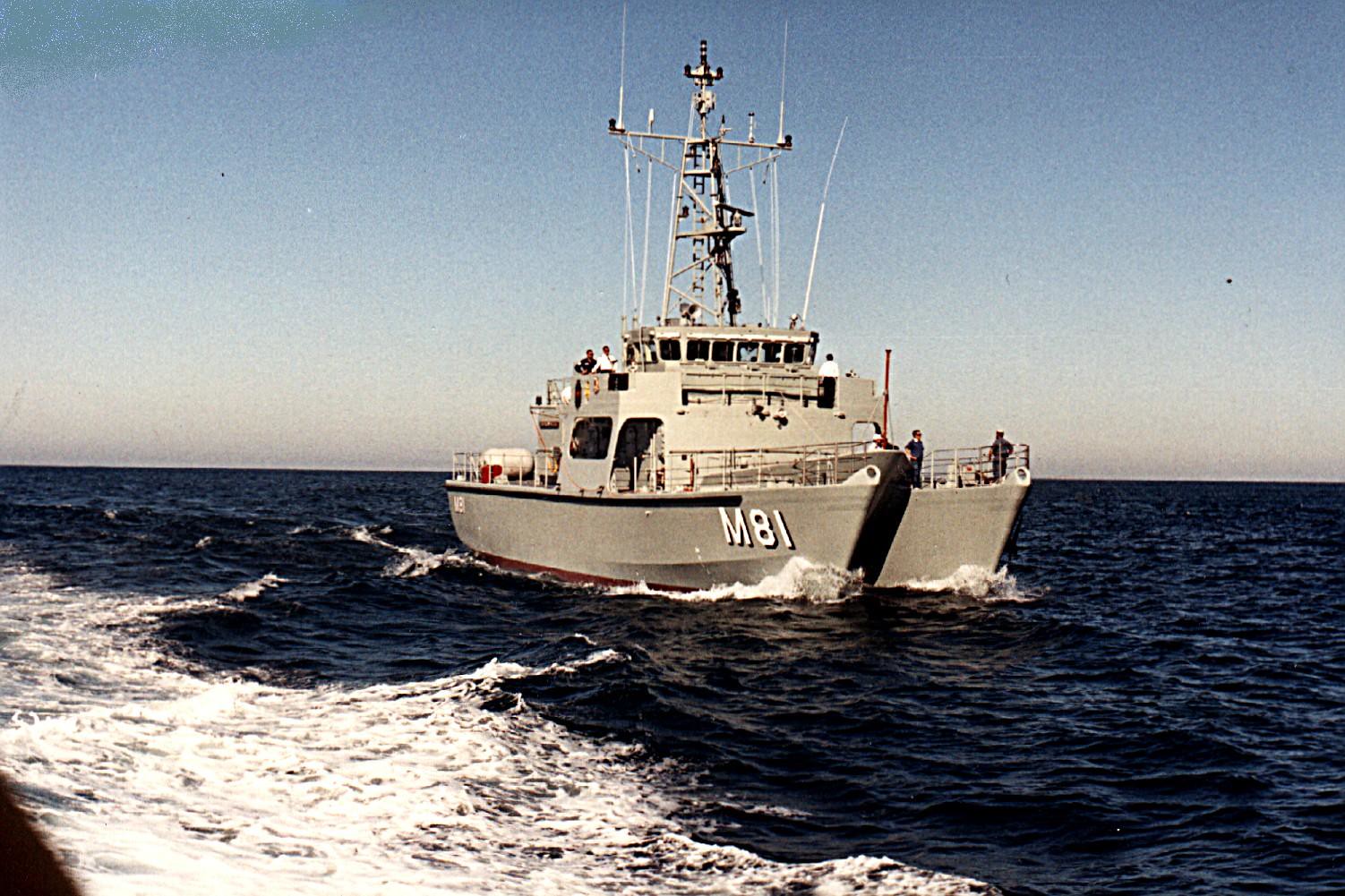
HMAS Shoalwater circa 1987 Photo Graeme Andrews, RAN 1955-1968, RANR 1980. From a private disc, with permission.
Rear Admiral Pete Quinn joined the Royal Australian Navy in 1983 from Mackay, Queensland. As a Principal Warfare Officer specialising in Above Water Warfare he has served in a wide variety of Navy, Joint and exchange appointments, including operational deployments to the North West Pacific, the Middle East and East Timor.
His seagoing service has primarily been in Australian and Canadian frigates and destroyers, including command appointments as Commanding Officer of the frigates HMAS Sydney (2003-2006) and HMAS Anzac (2009-2010). Early shore appointments include: Officer in Charge Maritime Warfare Training Group, Head of Combat Systems Training and Director Maritime Combat Development.
Star rank appointments have included: Director General Navy Capability Transition and Sustainment, Head Joint Capability Coordination, Head Joint Capability Management and Integration, Head Force Integration and his current position as Head Navy Capability.
As Head Navy Capability Rear Admiral Quinn reports directly to the Chief of Navy and is responsible for identifying the needs and requirements of Navy’s future capabilities and for the development and delivery of these capabilities to the Fleet.
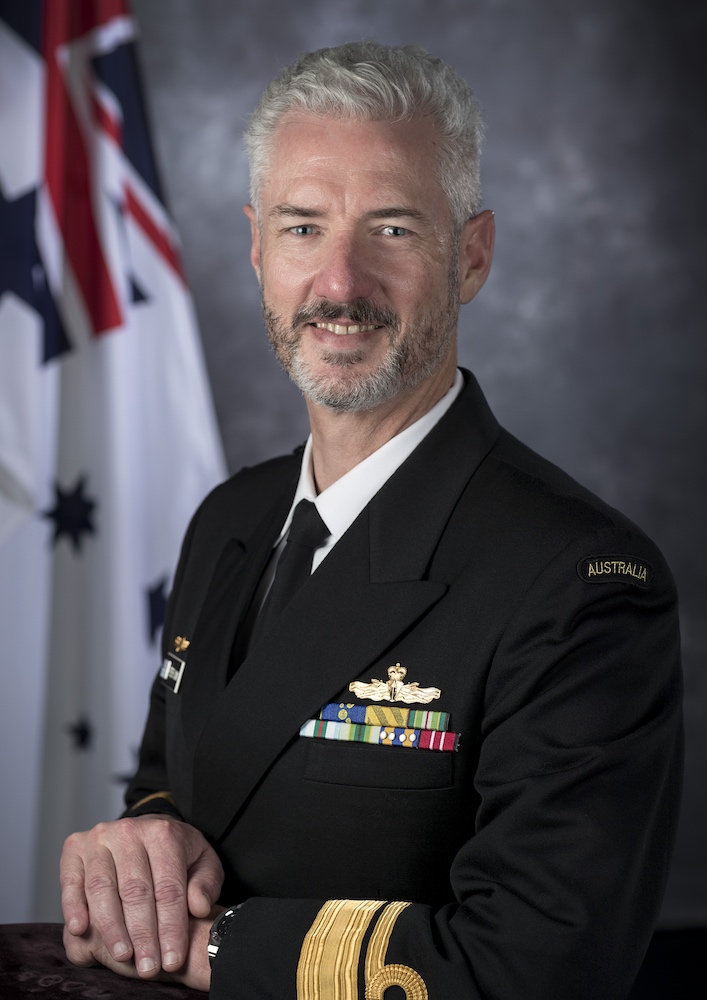
Rear Admiral Pete Quinn. Photo copyright Royal Australian Navy
Persian Gulf (July 19, 2005) - The amphibious dock landing ship USS Gunston Hall (LSD 44) conducts Surface Action Group operations during exercise Nautical Union. Nautical Union is a joint exercise between U.S. and coalition forces in the Persian Gulf. Nautical Union operations include conducting Maritime Security Operations (MSO) training, air defense, anti submarine warfare, surface warfare, mine counter measures, electronic warfare, replenishment at sea (RAS) and command and control. Maritime Security Operations (MSO) set the conditions for security and stability in the maritime environment as well as complements the counter-terrorism and security efforts of regional nations. U.S. Navy photo by Photographer's Mate 1st class Robert R. McRill (RELEASED)
_conducts_Surface_Action_Group_operations_during_exercise_Nautical_Union._Nautical_Union_is_a_joint_exercise_between_U.S..jpg?timestamp=1650693909831)
USS Gunston Hall